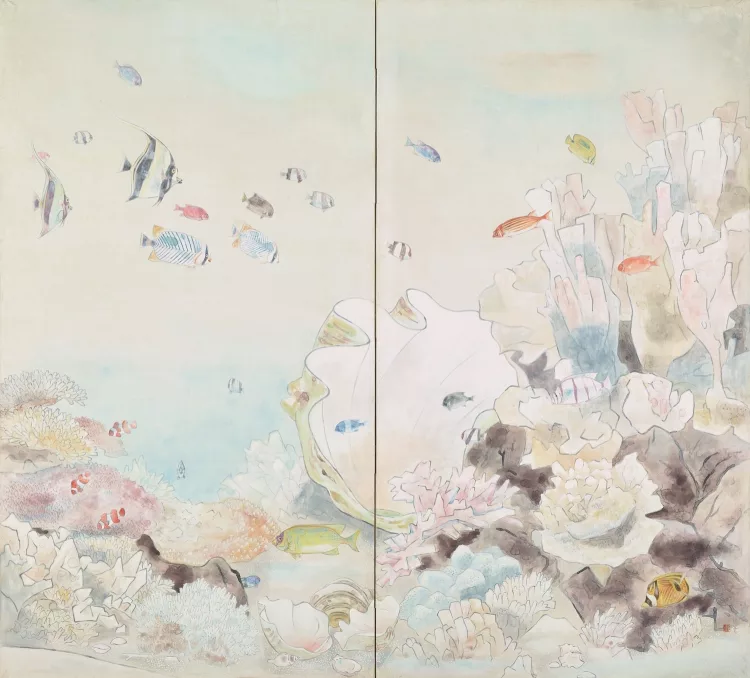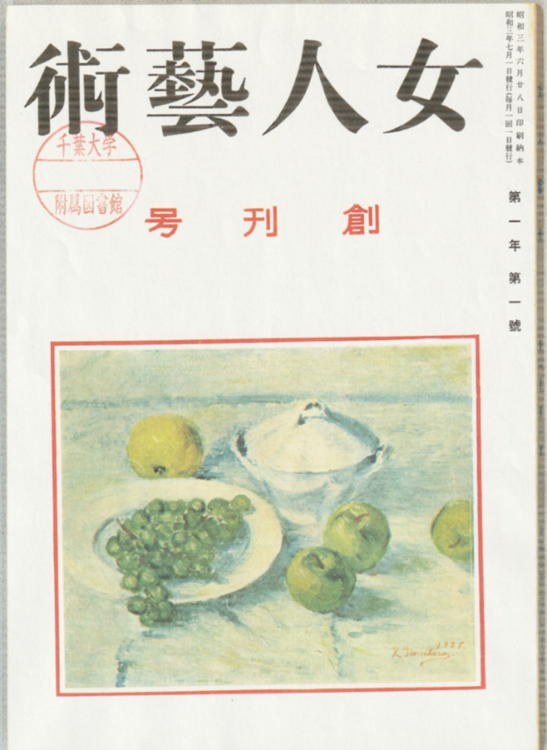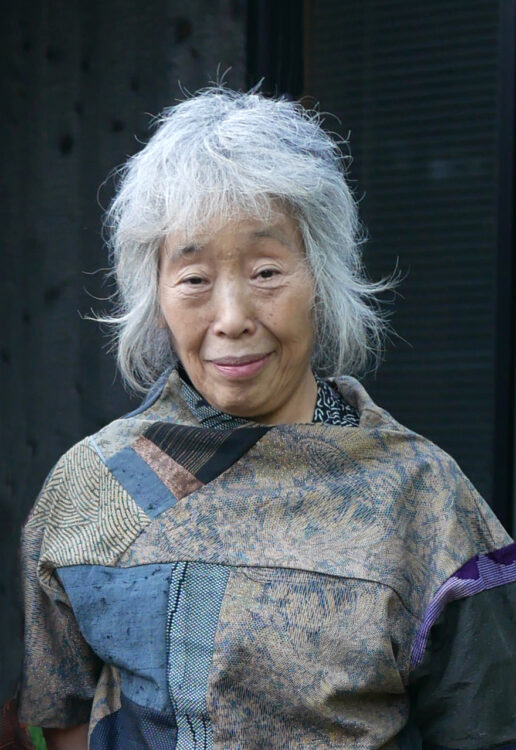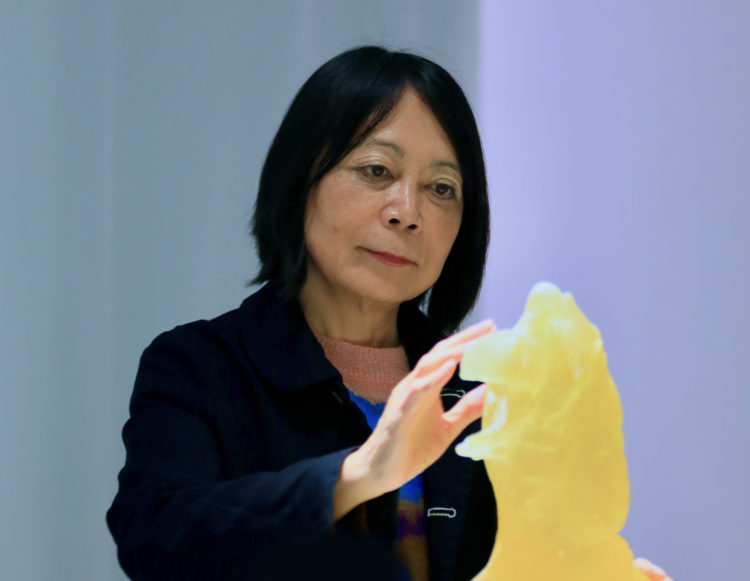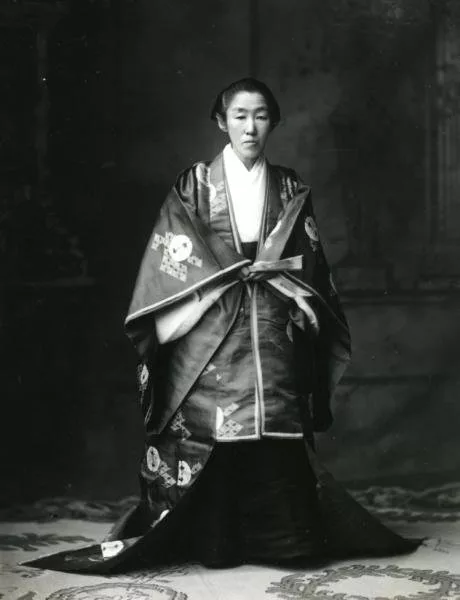Research
Kôai Takemura, Matsushima Shinkei [Matsushima Scenery], 1882, ink wash painting, 67.2 x 146.0 cm, collection: Jissouji Temple
In the Meiji period, a newly introduced exhibition system made significant changes to artists’ activities. Painted works were staged in public venues to be freely appreciated, compared, critiqued, and evaluated by untold numbers of people. The art world of modern Japan was built on such exhibitions. In this essay, I will examine the activities of Meiji-period woman artists of the Nanga (Southern Painting) School, with a particular emphasis on the two National Painting Competitive Exhibitions (Naikoku Kaiga Kyōshinkai) that were held in 1882 (Meiji 15) and 1884 (Meiji 17).
Following the Meiji Restoration, numerous artists from every corner of the country, including women artists, exhibited their works at the National Painting Competitive Exhibition, a government-run public exhibition held with an eye to reviving Japanese traditional arts, which were then in decline. A consultation of sources like A Brief List of Exhibitors at the 2nd National Painting Competitive Exhibition (Dai-ni-kai Naikoku Kaiga Kyōshinkai shuppinnin ryakufu) confirms that there were fifty-eight women artists over the course of the first and second exhibitions. Classifying them by school, thirty-four artists were from the Nanga School, five each from the Kano and Maruyama-Shijō Schools, and no more than three each from other schools. The Nanga School hence accounted for an overwhelming majority. Additionally, when we look at the activities of women artists in the School, the lion’s share—seventeen—were from Tokyo; five were from Osaka; two were from Oita Prefecture; and the remaining artists came singly from Iwate, Fukushima, Niigata, Nagano, Tochigi, Gifu, Kyoto, Hyogo, Ehime, and Tokushima prefectures, respectively. While the scarcity of Kyoto participants stands out, it is noteworthy that there were women artists of the Nanga School not just in the urban areas of Tokyo and Osaka but in rural areas as well.
To the extent that we can judge from the titles listed in the exhibition catalogue, more than 50% of the works exhibited by these Nanga-lineage women artists were bird-and-flower paintings (kachōga); slightly less than 40% were landscapes (sansuiga); and the remainder were paintings of vegetables (sosai), insects and fish (chūgyo), or figures (jinbutsu). Moreover, there are many instances of titles that are listed as simply “Landscape” (sansui) or “Flowers” (kusabana), making their specific contents unclear.
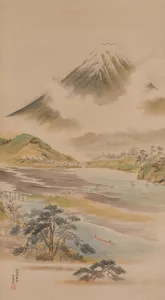
Kōai Takemura, View of Mt. Fuji from the Fuji River, 1903, colored silk, hanging scroll, 154.5 x 85.6 cm, Sanada Treasure Museum
Kōai Takemura’s (1852–1915) True-View of Matsushima (Matsushima shinkei), which was exhibited at the first exhibition and is currently held at Jissōji Temple in Kyoto, serves as a valuable example that enables us to acquaint ourselves with its subject matter and circumstances of production. The work displays Matsushima, one of Japan’s three famous views, and K. Takemura herself stated that she created it from a sketch made during a previous visit.1 In addition to Matsushima, K. Takemura frequently travelled across the country, including to Kamakura and Nikkō, and repeatedly created paintings based on the sketches made during her travels.
Kagai Hatano’s (1863–1944) Doro Gorge as Seen from the South (Minamiki Dorokyō zu), which was exhibited at the second exhibition and whose present-day whereabouts are unknown, was also painted following a visit to the actual location. K. Hatano travelled to Doro Gorge from Wakayama Prefecture in 1883 (Meiji 16). At that time, Doro Gorge was yet to become a tourist attraction, and transportation infrastructure was not yet completed. Furthermore, there was bad weather on the day of travel, and K. Hatano was urged by those around her to turn back. Despite this, she soldiered on—having determined that only by crossing rugged mountains and valleys would she be able to encounter this mysterious landscape—and finally arrived at Doro Gorge.2 It is said that K. Hatano created a painting based on the new properties of landscape that she discovered there, and we may surmise that it was this work that she exhibited.

Seiko Hashimoto, Landscapes of the Four Seasons, 1878, ink and color on paper, 147.8 × 340 cm, collection of Nozaki Family Historic Residence, Nozaki Family Historical Museum of Salt
One further noteworthy work is Seikō Hashimoto’s (1828–1905) True View of Sumiyoshi (Sumiyoshi shinkei), displayed at the first exhibition, which uses the name of a specific place in Japan for its title. S. Hashimoto was born in the Semba neighbourhood of Osaka and is said to have learned painting from a young age in the Sumiyoshi home of Hankō Okada (1782–1846).3 Thus, this work is also thought to have been based on an actual view of Sumiyoshi. Although more than two decades older than K. Takemura and K. Hatano, S. Hashimoto travelled from the Kinki and Chugoku regions to Shikoku and Kyushu, as well as to Atami (on the Izu Peninsula) and Tokyo, mingling with literati across the country and leaving behind various works.
Although we have only taken up these three exhibited works here, each of their artists personally toured these various locations and based—or are thought to have based—their depictions on the inspiration they received there. Given that these works were named for specific places, rather than given formulaic names like “Landscape,” we may surmise that their creators took pride in the fact that they were different from other, generic landscape paintings.

Shōhin Noguchi, Yuki Chihō Fūzoku-uta Byōbu [Poetry and Genre Scenes from Yuki Province for Daijosai (Grand Thanksgiving Festival after the Enthronement) of Emperor Taisho], 1915, color on paper, 229 x 524 cm, collection of the Museum of the Imperial Collections, Sannomaru Shozokan
Also noteworthy, in terms of awards, is Shōhin Noguchi (1847–1917). Six women were awarded commendations across the two National Painting Competitive Exhibitions, but S. Noguchi was the only one to win twice. She displayed paintings titled Landscape and Sweet Olive (Keika) at the first exhibition and Landscape and Flowers at the second exhibition. Although we cannot guess the particulars of these works from their titles, we do know that she exhibited one landscape and one bird-and-flower painting at each exhibition. A leading woman artist of the Meiji period, S. Noguchi stood out from other women artists in terms of her exhibition activities. She presented work both domestically and abroad, including at the Japan Art Association Exhibition (Nihon Bijutsu Kyōkaiten) and, in 1904 (Meiji 37), she became the first woman to be selected as an Imperial Household Artist (teishitsu gigei’in). She was commissioned to paint the folding screen Folk Songs of the Yuki Provinces (Yūki chihō fūzoku’uta byōbu) for the 1915 enthronement ceremony of Emperor Taisho.

Shōhin Noguchi, Hakone Shinkeizu Byōbu [Scenes of Hakone], 1907, color on paper, 128.5 × 303.1 cm each, Yamatane Museum of Art
In the late 1880s and early 1890s, S. Noguchi, as a painter pursuing new landscape expression in the Meiji period, also concentrated her efforts on landscape paintings based on sketches of existing scenery. In 1893 (Meiji 26), she exhibited True View of Tengu Rock in Yashū, Shiobara (Yashū Shiobara tengu iwa shinkei) at the World’s Columbian Exhibition, which was based on an actual view in Shiobara. Thereafter, she went on to paint Japanese landscapes based on real scenery in a milder style, such as in her True View of Hakone (Hakone shinkei zu byōbu.
Returning to the topic of Meiji-period Nanga painting, following its criticism by Ernest Fenollosa (1853–1908) in 1882, censure of formalist expression surged, and these landscapes by K. Takemura and others that were based on sketches from nature were attempted against this historical backdrop. K. Takemura, in particular, had a strong awareness of the need to improve Japanese painting even before Fenollosa’s criticism of Nanga, and she made an active study of Western-style painting, applying that study to her own works.4
Of the four artists we’ve looked at thus far, the eldest—S. Hashimoto—continued exhibiting her works at such venues as the National Industrial Exhibitions (Naikoku Kangyō Hakurankai), but she did so infrequently and passed away in 1905 (Meiji 38). K. Hatano exhibited her work at the 3rd National Industrial Exhibition in 1890 (Meiji 23) but married in 1896 (Meiji 29) and gave up the art world for a time. By contrast, S. Noguchi and K. Takemura were proactive in submitting their work to exhibitions from the 1880s on, though their primary venue was the Japan Art Association (founded as the Ryūchikai in 1879 and renamed in 1887). Indeed, many women artists were active participants in the Japan Art Association exhibitions. In the Meiji period, Nanga-lineage artists—including S. Noguchi, K. Takemura, Seisui Okuhara (1854–1921), Hōkoku Takabayashi (1840–1894), Seikoku Sakuma (1868–?), Settei Matsubayashi (1870–1970), Gyokushi Atomi (1858–1943), and Shōkei Noguchi (1878–1945)—won gold, silver, and bronze medals at the exhibitions.
Some of these Nanga-lineage women artists also held positions within the organizations that they belonged to. Shōhin Noguchi served as a committee member and a committee advisor within the Painting Division of the Japan Art Association, which was that organization’s first division, and S. Okuhara also served as a committee member within that division. K. Takemura served as secretary of the Japan Southern School Artists Association (Nihon Nanshū Gakai), while S. Okuhara served as a committee member. K. Takemura, S. Okuhara, G. Atomi, and Seigaku Suzuki (dates unknown) all served as secretaries of the Society of Japanese-style Painting (Nihon Gakai). K. Takemura, S. Okuhara, G. Atomi, and Seikin Masugi (1875–1910) all served as trustees of the Seiha Doshikai, which was formed in 1907 amid the antagonism surrounding the establishment of the Bunten Exhibition.
In this manner, the Meiji period saw the active participation of Nanga-lineage women artists, mainly at the exhibitions of the Japan Art Association, but—owing to the delayed recognition of the Japan Art Association and of so-called old school artists, including Nanga artists—little attention has been paid to their activities until now. Although this phenomenon is by no means limited to women artists, it is my hope that, in shedding light on these artists and promoting a reevaluation of their work, we can usher in a greater diversity of perspectives to the existing history of modern Japanese art.
Tai Tadokoro, “Takemura Kōai to Meiji jidai no josei Nihongaka ni kan suru kenkyū” [Kōai Takemura and Women Nihonga Painters in the Meiji Period], Bijutsu kenkyū 427 (March 2019): 28.
2
Fūta Itogawa, “Hatano Kagai no Dorokyō hōmon” [Kagai Hatano’s Visit to Doro Gorge], in Senkyō: Nanga no seichi, koko ni ari (Wakayama: Museum of Modern Art, 2024), 92.
3
Hōtanshi (nom-de-plume of newspaperman Kurō Katō, 1830–1890), “Yomiuri zōtan” [Yomiuri Tidbits], Yomiuri Shimbun (Tokyo, Japan), September 2, 1880: 1.
4
Tadokoro, 27.
Tai Tadokoro is Curator at the Sen-Oku Hakukokan Museum in Tokyo. He received an MA in art history from the Faculty of Letters and Sciences at Waseda University in March 2015. Previously, he was Associate Fellow at the Planning and Information Department of the National Research Institute for Cultural Properties, Tokyo (renamed the Cultural Properties Information and Materials Department in April 2016); Head Curator at the Suginami Municipal Folk Museum; and Curator at the Kōsetsu Memorial Museum of Jissen Women’s University. In addition to his work on women bijingaartists, like Shōen Uemura and Gyokuyō Uehara, he conducts research on women Nanga artists, including Kōai Takemura, Seikō Hashimoto, and Kagai Hatano.
Tai Tadokoro, "Women Nanga Artists at Meiji-Period Exhibitions." In Archives of Women Artists, Research and Exhibitions magazine, . URL : https://awarewomenartists.com/en/magazine/femmes-peintres-de-nanga-qui-sillustrerent-dans-les-salons-de-lere-meiji/. Accessed 14 November 2025




